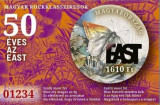
1. MAGYAR - 150 éve született Róth Miksa speciál változatok és bélyegszett Bélyeg vásárlás >>
2. ENGLISH - Miksa Róth was born 150 years ago special edition and stamp set Order stamp >>
1. MAGYAR - 150 éve született Róth Miksa speciál változatok és bélyegszett
A Magyar Posta – a június 4-én kibocsátott – 150 éve született Róth Miksa c. alkalmi bélyegblokk mellett speciális bélyegblokkok és reprezentatív bélyegszett kibocsátásával is köszönti a neves művész születési évfordulóját. A piros sorszámozású vágott és a zöld sorszámozású különlegesen perforált bélyegblokkon is a díjnyertes Pax c. mozaik látható. A szett az alap- és a speciál változatok mellett tartalmaz egy limitált, mindösszesen 650 példányban készült egyszínnyomatot is. A bélyegblokk és a folder Kara György grafikusművész tervei alapján készült.
Róth Miksa (1865–1944) máig a legismertebb és legelismertebb magyar üvegfestő- és mozaikművész. Az ő üvegablakai díszítik többek között a burgenlandi máriafalvi gótikus templomot, az Országházat, a (mai) Pénzügy- és Belügyminisztérium valamint a Magyar Nemzeti Bank épületét, az 1903-ban újjáépített Vajdahunyad várát és a jáki kápolnává alakított egykori királyi pihenőt. Mozaikképei közül ma is látható a budapesti Szervita téren az egykori Török Bankház homlokzatán a Patrona Hungariae, a főváros legnagyobb köztéri mozaikja, a pannonhalmi apátsági templom homlokzatán az alapítást szimbolizáló mozaik, Vajda Zsigmonddal pedig a Széchenyi fürdő kupolacsarnokának világos, modern mozaikdíszét készítették el. A mozaikkészítés magyarországi meghonosításáért elnyerte a Ferenc József-rend lovagi fokozatát. 1900-ban Párizsban a szecesszió első nagy nemzetközi seregszemléjén ezüstéremmel tüntették ki. Később a torinói és a Saint Louis-i világkiállításokon aranyérmet kapott és a mozaiktechnika megújításért elnyerte az olasz király aranyérmét is. (Forrás: Fényi Tibor kézirata - Róth Miksa Emlékház) A RÓTH bélyegszetthez sorszámozott, magyar és angol nyelvű „Tanúsítvány” tartozik, mely eredetiségét postai szárazbélyegző igazolja. Visszazárható fóliatasakban kerül árusításra. A csomagolásként szolgáló folder címoldalán Róth Miksa portréja látható. A kiadvány további oldalain magyar és angol nyelven Róth Miksa önéletrajza olvasható. A bélyegblokkokat és az egyszínnyomatot ún. filacsík védi.
Forrás: Posta
2. ENGLISH - Miksa Róth was born 150 years ago special edition and stamp set
Magyar Posta is celebrating the 150th anniversary of the birth of Miksa Róth by issuing special commemorative stamp blocks and an exclusive set of stamps in addition to the commemorative stamp block released on 4 June. The Pax mosaic designed by Miksa Róth, is featured on the red numbered imperforated and the green numbered specially perforated stamp blocks, which have the same design as the standard version. Besides the standard and special editions, the set contains a limited monochrome version, of which only 650 copies have been printed. The stamp blocks and the folder were produced using designs by György Kara.
Miksa Róth (1865–1944) is the best known and most highly acclaimed Hungarian glass stainer and mosaic artist who ever lived. Among the buildings adorned by Róth’s stained-glass windows are the Gothic church of Mariasdorf in Burgenland, the Hungarian Parliament, the buildings of today’s Ministries of Finance and Interior, and the Central Bank of Hungary as well as the Vajdahunyad Castle, which was rebuilt in 1903, and the former royal retreat, which was converted into the Chapel of Ják. Of his mosaics, those which can still be seen today include the capital’s largest public mosaic, Patrona Hungariae on the facade of the former Turkish Bank House on Szervita Square in Budapest; the mosaic symbolising the foundation of Pannonhalma Abbey on the facade of the church there; and the light modern mosaic decoration of the dome hall of the Széchenyi Baths executed in conjunction with Zsigmond Vajda. Róth was awarded the title of Knight of the Order of Franz Joseph for the successful introduction of the art of mosaic-making in Hungary. In 1900 he won a silver medal at the first major international review of the Secession in Paris. Later he was awarded a gold medal in world expositions in Turin and Saint Louis, and received the Italian king’s gold medal for reviving mosaic technique. (Source: Tibor Fényi’s manuscript – Miksa Róth Memorial House) The RÓTH Stamp Set comes with a numbered Certificate in Hungarian and English bearing an embossed postal seal verifying its originality. It is sold in a resealable pouch. The cover of the folder, which also serves as packaging, bears the portrait of Miksa Róth. On the other pages there is a biography of Miksa Róth in Hungarian and English. The stamp blocks and the monochrome edition are protected in mounts.










